Pathology Immunology And Epidemology
VerifiedAdded on 2022/08/12
|12
|3877
|21
AI Summary
hello, please see my requirements below: 1) There are two questions in RED which i need help on 2) All references for each question should be incited and also mentioned on a reference page at the bottom of the assignment in harvard format 3) Total word count of my assignment should be 3,300 including all references
Contribute Materials
Your contribution can guide someone’s learning journey. Share your
documents today.
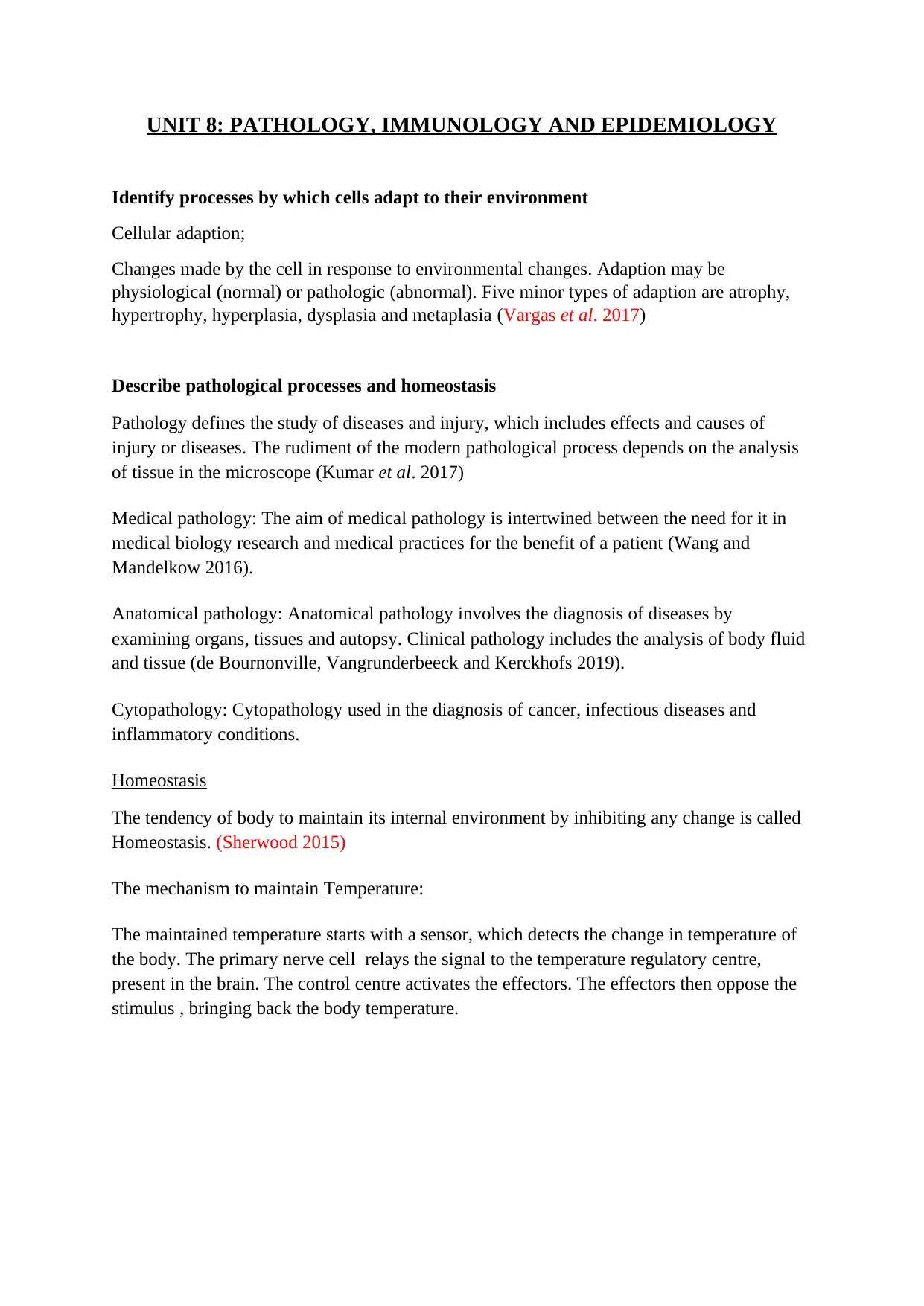
UNIT 8: PATHOLOGY, IMMUNOLOGY AND EPIDEMIOLOGY
Identify processes by which cells adapt to their environment
Cellular adaption;
Changes made by the cell in response to environmental changes. Adaption may be
physiological (normal) or pathologic (abnormal). Five minor types of adaption are atrophy,
hypertrophy, hyperplasia, dysplasia and metaplasia (Vargas et al. 2017)
Describe pathological processes and homeostasis
Pathology defines the study of diseases and injury, which includes effects and causes of
injury or diseases. The rudiment of the modern pathological process depends on the analysis
of tissue in the microscope (Kumar et al. 2017)
Medical pathology: The aim of medical pathology is intertwined between the need for it in
medical biology research and medical practices for the benefit of a patient (Wang and
Mandelkow 2016).
Anatomical pathology: Anatomical pathology involves the diagnosis of diseases by
examining organs, tissues and autopsy. Clinical pathology includes the analysis of body fluid
and tissue (de Bournonville, Vangrunderbeeck and Kerckhofs 2019).
Cytopathology: Cytopathology used in the diagnosis of cancer, infectious diseases and
inflammatory conditions.
Homeostasis
The tendency of body to maintain its internal environment by inhibiting any change is called
Homeostasis. (Sherwood 2015)
The mechanism to maintain Temperature:
The maintained temperature starts with a sensor, which detects the change in temperature of
the body. The primary nerve cell relays the signal to the temperature regulatory centre,
present in the brain. The control centre activates the effectors. The effectors then oppose the
stimulus , bringing back the body temperature.
Identify processes by which cells adapt to their environment
Cellular adaption;
Changes made by the cell in response to environmental changes. Adaption may be
physiological (normal) or pathologic (abnormal). Five minor types of adaption are atrophy,
hypertrophy, hyperplasia, dysplasia and metaplasia (Vargas et al. 2017)
Describe pathological processes and homeostasis
Pathology defines the study of diseases and injury, which includes effects and causes of
injury or diseases. The rudiment of the modern pathological process depends on the analysis
of tissue in the microscope (Kumar et al. 2017)
Medical pathology: The aim of medical pathology is intertwined between the need for it in
medical biology research and medical practices for the benefit of a patient (Wang and
Mandelkow 2016).
Anatomical pathology: Anatomical pathology involves the diagnosis of diseases by
examining organs, tissues and autopsy. Clinical pathology includes the analysis of body fluid
and tissue (de Bournonville, Vangrunderbeeck and Kerckhofs 2019).
Cytopathology: Cytopathology used in the diagnosis of cancer, infectious diseases and
inflammatory conditions.
Homeostasis
The tendency of body to maintain its internal environment by inhibiting any change is called
Homeostasis. (Sherwood 2015)
The mechanism to maintain Temperature:
The maintained temperature starts with a sensor, which detects the change in temperature of
the body. The primary nerve cell relays the signal to the temperature regulatory centre,
present in the brain. The control centre activates the effectors. The effectors then oppose the
stimulus , bringing back the body temperature.
Secure Best Marks with AI Grader
Need help grading? Try our AI Grader for instant feedback on your assignments.
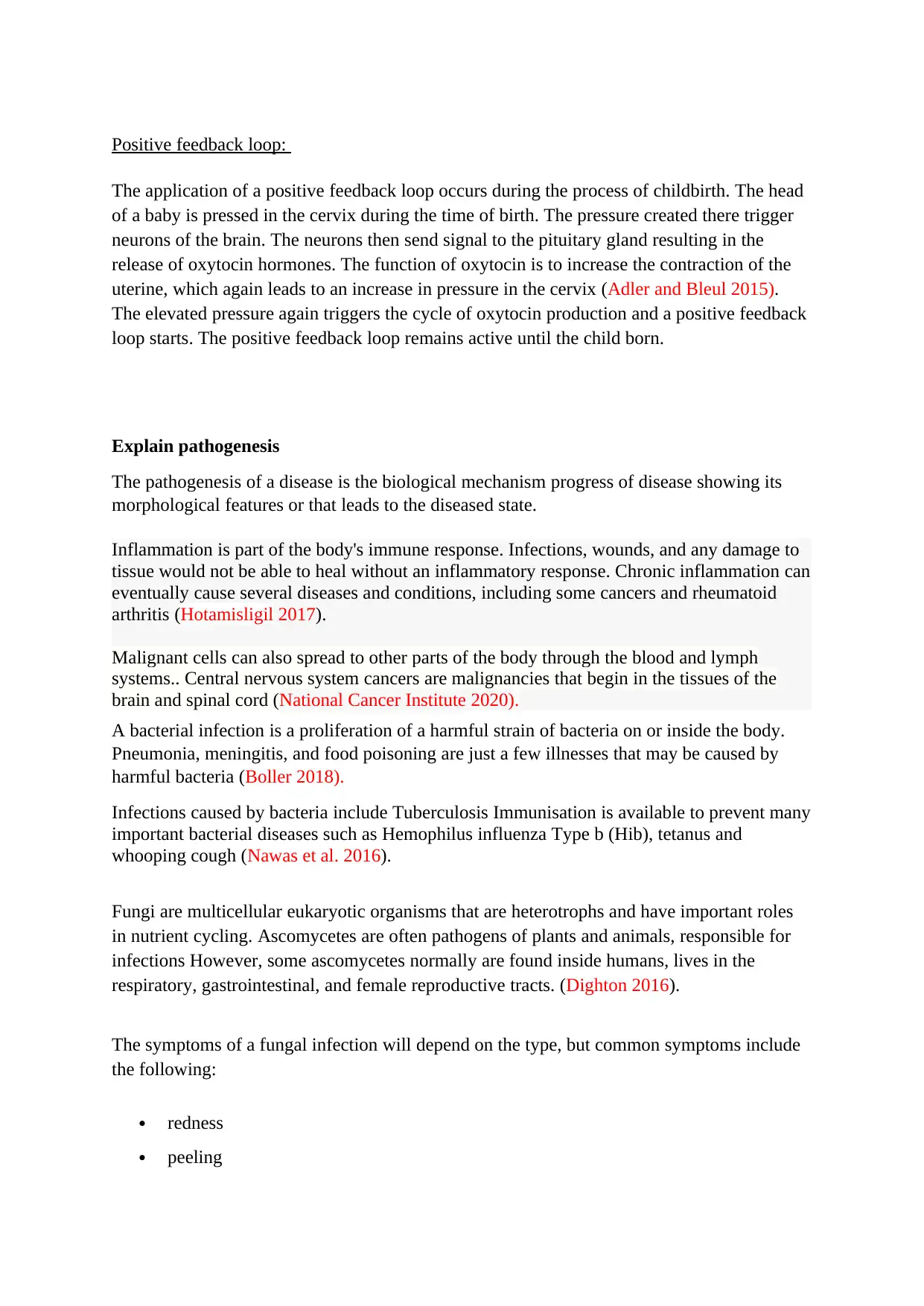
Positive feedback loop:
The application of a positive feedback loop occurs during the process of childbirth. The head
of a baby is pressed in the cervix during the time of birth. The pressure created there trigger
neurons of the brain. The neurons then send signal to the pituitary gland resulting in the
release of oxytocin hormones. The function of oxytocin is to increase the contraction of the
uterine, which again leads to an increase in pressure in the cervix (Adler and Bleul 2015).
The elevated pressure again triggers the cycle of oxytocin production and a positive feedback
loop starts. The positive feedback loop remains active until the child born.
Explain pathogenesis
The pathogenesis of a disease is the biological mechanism progress of disease showing its
morphological features or that leads to the diseased state.
Inflammation is part of the body's immune response. Infections, wounds, and any damage to
tissue would not be able to heal without an inflammatory response. Chronic inflammation can
eventually cause several diseases and conditions, including some cancers and rheumatoid
arthritis (Hotamisligil 2017).
Malignant cells can also spread to other parts of the body through the blood and lymph
systems.. Central nervous system cancers are malignancies that begin in the tissues of the
brain and spinal cord (National Cancer Institute 2020).
A bacterial infection is a proliferation of a harmful strain of bacteria on or inside the body.
Pneumonia, meningitis, and food poisoning are just a few illnesses that may be caused by
harmful bacteria (Boller 2018).
Infections caused by bacteria include Tuberculosis Immunisation is available to prevent many
important bacterial diseases such as Hemophilus influenza Type b (Hib), tetanus and
whooping cough (Nawas et al. 2016).
Fungi are multicellular eukaryotic organisms that are heterotrophs and have important roles
in nutrient cycling. Ascomycetes are often pathogens of plants and animals, responsible for
infections However, some ascomycetes normally are found inside humans, lives in the
respiratory, gastrointestinal, and female reproductive tracts. (Dighton 2016).
The symptoms of a fungal infection will depend on the type, but common symptoms include
the following:
redness
peeling
The application of a positive feedback loop occurs during the process of childbirth. The head
of a baby is pressed in the cervix during the time of birth. The pressure created there trigger
neurons of the brain. The neurons then send signal to the pituitary gland resulting in the
release of oxytocin hormones. The function of oxytocin is to increase the contraction of the
uterine, which again leads to an increase in pressure in the cervix (Adler and Bleul 2015).
The elevated pressure again triggers the cycle of oxytocin production and a positive feedback
loop starts. The positive feedback loop remains active until the child born.
Explain pathogenesis
The pathogenesis of a disease is the biological mechanism progress of disease showing its
morphological features or that leads to the diseased state.
Inflammation is part of the body's immune response. Infections, wounds, and any damage to
tissue would not be able to heal without an inflammatory response. Chronic inflammation can
eventually cause several diseases and conditions, including some cancers and rheumatoid
arthritis (Hotamisligil 2017).
Malignant cells can also spread to other parts of the body through the blood and lymph
systems.. Central nervous system cancers are malignancies that begin in the tissues of the
brain and spinal cord (National Cancer Institute 2020).
A bacterial infection is a proliferation of a harmful strain of bacteria on or inside the body.
Pneumonia, meningitis, and food poisoning are just a few illnesses that may be caused by
harmful bacteria (Boller 2018).
Infections caused by bacteria include Tuberculosis Immunisation is available to prevent many
important bacterial diseases such as Hemophilus influenza Type b (Hib), tetanus and
whooping cough (Nawas et al. 2016).
Fungi are multicellular eukaryotic organisms that are heterotrophs and have important roles
in nutrient cycling. Ascomycetes are often pathogens of plants and animals, responsible for
infections However, some ascomycetes normally are found inside humans, lives in the
respiratory, gastrointestinal, and female reproductive tracts. (Dighton 2016).
The symptoms of a fungal infection will depend on the type, but common symptoms include
the following:
redness
peeling
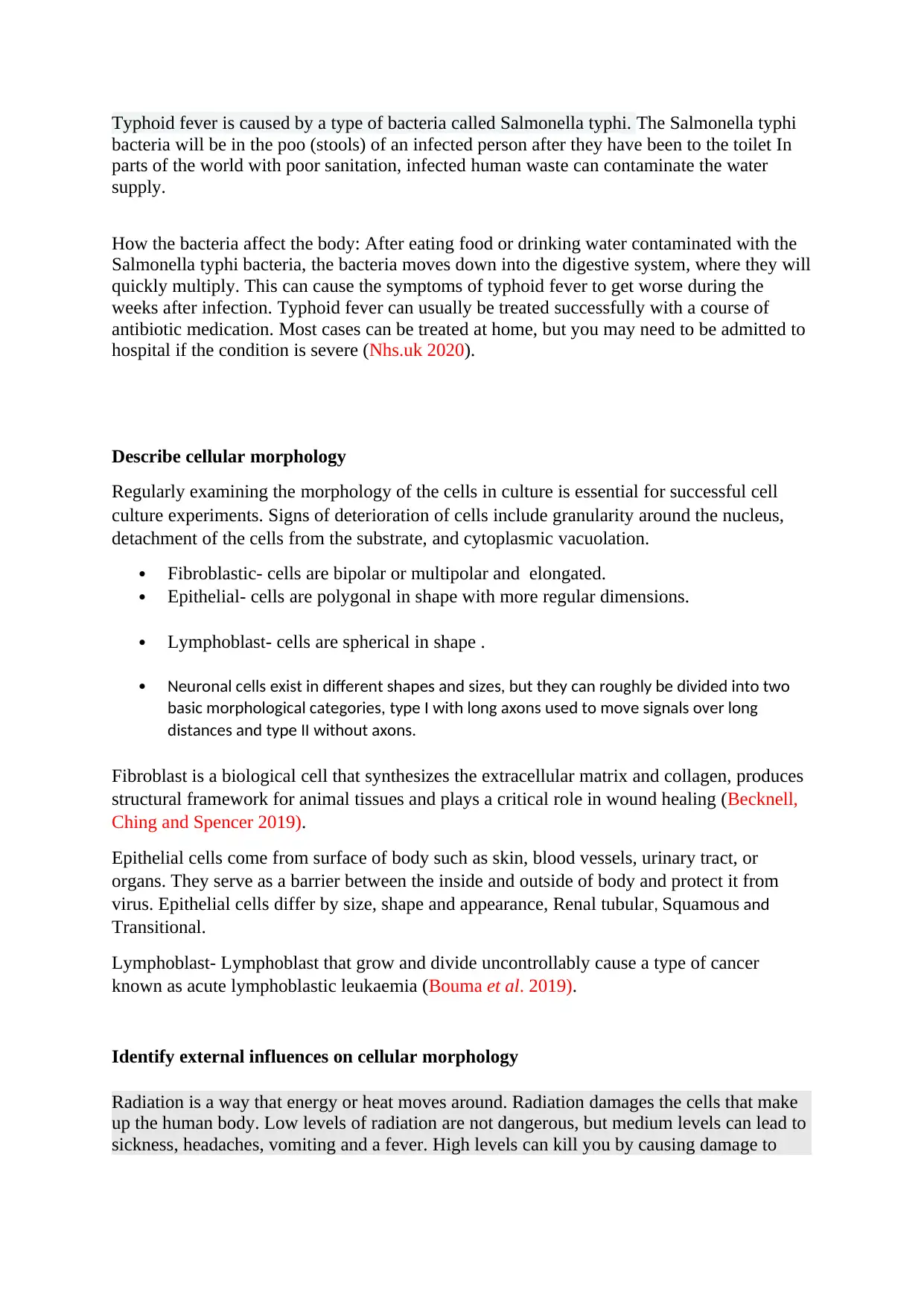
Typhoid fever is caused by a type of bacteria called Salmonella typhi. The Salmonella typhi
bacteria will be in the poo (stools) of an infected person after they have been to the toilet In
parts of the world with poor sanitation, infected human waste can contaminate the water
supply.
How the bacteria affect the body: After eating food or drinking water contaminated with the
Salmonella typhi bacteria, the bacteria moves down into the digestive system, where they will
quickly multiply. This can cause the symptoms of typhoid fever to get worse during the
weeks after infection. Typhoid fever can usually be treated successfully with a course of
antibiotic medication. Most cases can be treated at home, but you may need to be admitted to
hospital if the condition is severe (Nhs.uk 2020).
Describe cellular morphology
Regularly examining the morphology of the cells in culture is essential for successful cell
culture experiments. Signs of deterioration of cells include granularity around the nucleus,
detachment of the cells from the substrate, and cytoplasmic vacuolation.
Fibroblastic- cells are bipolar or multipolar and elongated.
Epithelial- cells are polygonal in shape with more regular dimensions.
Lymphoblast- cells are spherical in shape .
Neuronal cells exist in different shapes and sizes, but they can roughly be divided into two
basic morphological categories, type I with long axons used to move signals over long
distances and type II without axons.
Fibroblast is a biological cell that synthesizes the extracellular matrix and collagen, produces
structural framework for animal tissues and plays a critical role in wound healing (Becknell,
Ching and Spencer 2019).
Epithelial cells come from surface of body such as skin, blood vessels, urinary tract, or
organs. They serve as a barrier between the inside and outside of body and protect it from
virus. Epithelial cells differ by size, shape and appearance, Renal tubular, Squamous and
Transitional.
Lymphoblast- Lymphoblast that grow and divide uncontrollably cause a type of cancer
known as acute lymphoblastic leukaemia (Bouma et al. 2019).
Identify external influences on cellular morphology
Radiation is a way that energy or heat moves around. Radiation damages the cells that make
up the human body. Low levels of radiation are not dangerous, but medium levels can lead to
sickness, headaches, vomiting and a fever. High levels can kill you by causing damage to
bacteria will be in the poo (stools) of an infected person after they have been to the toilet In
parts of the world with poor sanitation, infected human waste can contaminate the water
supply.
How the bacteria affect the body: After eating food or drinking water contaminated with the
Salmonella typhi bacteria, the bacteria moves down into the digestive system, where they will
quickly multiply. This can cause the symptoms of typhoid fever to get worse during the
weeks after infection. Typhoid fever can usually be treated successfully with a course of
antibiotic medication. Most cases can be treated at home, but you may need to be admitted to
hospital if the condition is severe (Nhs.uk 2020).
Describe cellular morphology
Regularly examining the morphology of the cells in culture is essential for successful cell
culture experiments. Signs of deterioration of cells include granularity around the nucleus,
detachment of the cells from the substrate, and cytoplasmic vacuolation.
Fibroblastic- cells are bipolar or multipolar and elongated.
Epithelial- cells are polygonal in shape with more regular dimensions.
Lymphoblast- cells are spherical in shape .
Neuronal cells exist in different shapes and sizes, but they can roughly be divided into two
basic morphological categories, type I with long axons used to move signals over long
distances and type II without axons.
Fibroblast is a biological cell that synthesizes the extracellular matrix and collagen, produces
structural framework for animal tissues and plays a critical role in wound healing (Becknell,
Ching and Spencer 2019).
Epithelial cells come from surface of body such as skin, blood vessels, urinary tract, or
organs. They serve as a barrier between the inside and outside of body and protect it from
virus. Epithelial cells differ by size, shape and appearance, Renal tubular, Squamous and
Transitional.
Lymphoblast- Lymphoblast that grow and divide uncontrollably cause a type of cancer
known as acute lymphoblastic leukaemia (Bouma et al. 2019).
Identify external influences on cellular morphology
Radiation is a way that energy or heat moves around. Radiation damages the cells that make
up the human body. Low levels of radiation are not dangerous, but medium levels can lead to
sickness, headaches, vomiting and a fever. High levels can kill you by causing damage to
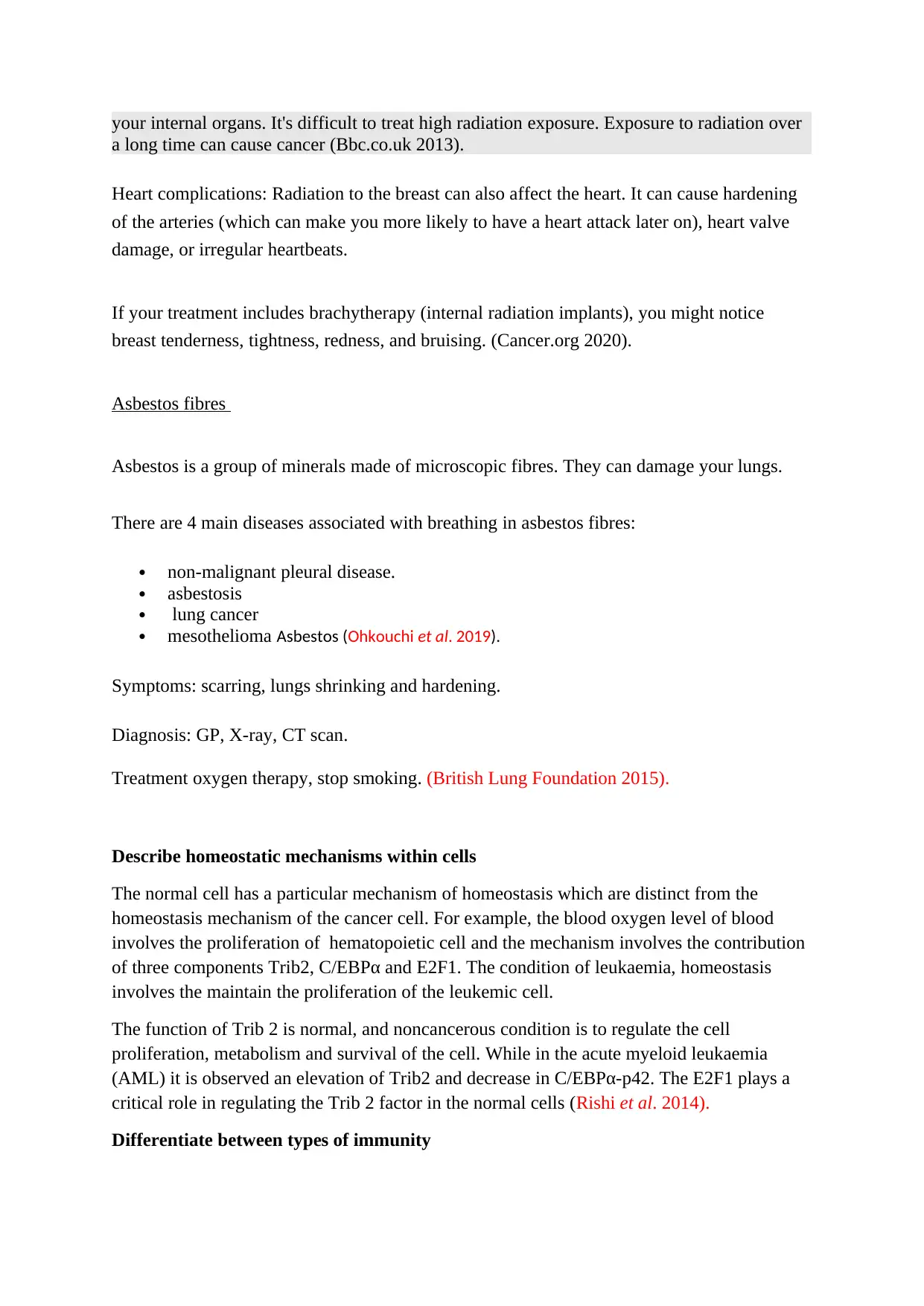
your internal organs. It's difficult to treat high radiation exposure. Exposure to radiation over
a long time can cause cancer (Bbc.co.uk 2013).
Heart complications: Radiation to the breast can also affect the heart. It can cause hardening
of the arteries (which can make you more likely to have a heart attack later on), heart valve
damage, or irregular heartbeats.
If your treatment includes brachytherapy (internal radiation implants), you might notice
breast tenderness, tightness, redness, and bruising. (Cancer.org 2020).
Asbestos fibres
Asbestos is a group of minerals made of microscopic fibres. They can damage your lungs.
There are 4 main diseases associated with breathing in asbestos fibres:
non-malignant pleural disease.
asbestosis
lung cancer
mesothelioma Asbestos (Ohkouchi et al. 2019).
Symptoms: scarring, lungs shrinking and hardening.
Diagnosis: GP, X-ray, CT scan.
Treatment oxygen therapy, stop smoking. (British Lung Foundation 2015).
Describe homeostatic mechanisms within cells
The normal cell has a particular mechanism of homeostasis which are distinct from the
homeostasis mechanism of the cancer cell. For example, the blood oxygen level of blood
involves the proliferation of hematopoietic cell and the mechanism involves the contribution
of three components Trib2, C/EBPα and E2F1. The condition of leukaemia, homeostasis
involves the maintain the proliferation of the leukemic cell.
The function of Trib 2 is normal, and noncancerous condition is to regulate the cell
proliferation, metabolism and survival of the cell. While in the acute myeloid leukaemia
(AML) it is observed an elevation of Trib2 and decrease in C/EBPα-p42. The E2F1 plays a
critical role in regulating the Trib 2 factor in the normal cells (Rishi et al. 2014).
Differentiate between types of immunity
a long time can cause cancer (Bbc.co.uk 2013).
Heart complications: Radiation to the breast can also affect the heart. It can cause hardening
of the arteries (which can make you more likely to have a heart attack later on), heart valve
damage, or irregular heartbeats.
If your treatment includes brachytherapy (internal radiation implants), you might notice
breast tenderness, tightness, redness, and bruising. (Cancer.org 2020).
Asbestos fibres
Asbestos is a group of minerals made of microscopic fibres. They can damage your lungs.
There are 4 main diseases associated with breathing in asbestos fibres:
non-malignant pleural disease.
asbestosis
lung cancer
mesothelioma Asbestos (Ohkouchi et al. 2019).
Symptoms: scarring, lungs shrinking and hardening.
Diagnosis: GP, X-ray, CT scan.
Treatment oxygen therapy, stop smoking. (British Lung Foundation 2015).
Describe homeostatic mechanisms within cells
The normal cell has a particular mechanism of homeostasis which are distinct from the
homeostasis mechanism of the cancer cell. For example, the blood oxygen level of blood
involves the proliferation of hematopoietic cell and the mechanism involves the contribution
of three components Trib2, C/EBPα and E2F1. The condition of leukaemia, homeostasis
involves the maintain the proliferation of the leukemic cell.
The function of Trib 2 is normal, and noncancerous condition is to regulate the cell
proliferation, metabolism and survival of the cell. While in the acute myeloid leukaemia
(AML) it is observed an elevation of Trib2 and decrease in C/EBPα-p42. The E2F1 plays a
critical role in regulating the Trib 2 factor in the normal cells (Rishi et al. 2014).
Differentiate between types of immunity
Secure Best Marks with AI Grader
Need help grading? Try our AI Grader for instant feedback on your assignments.
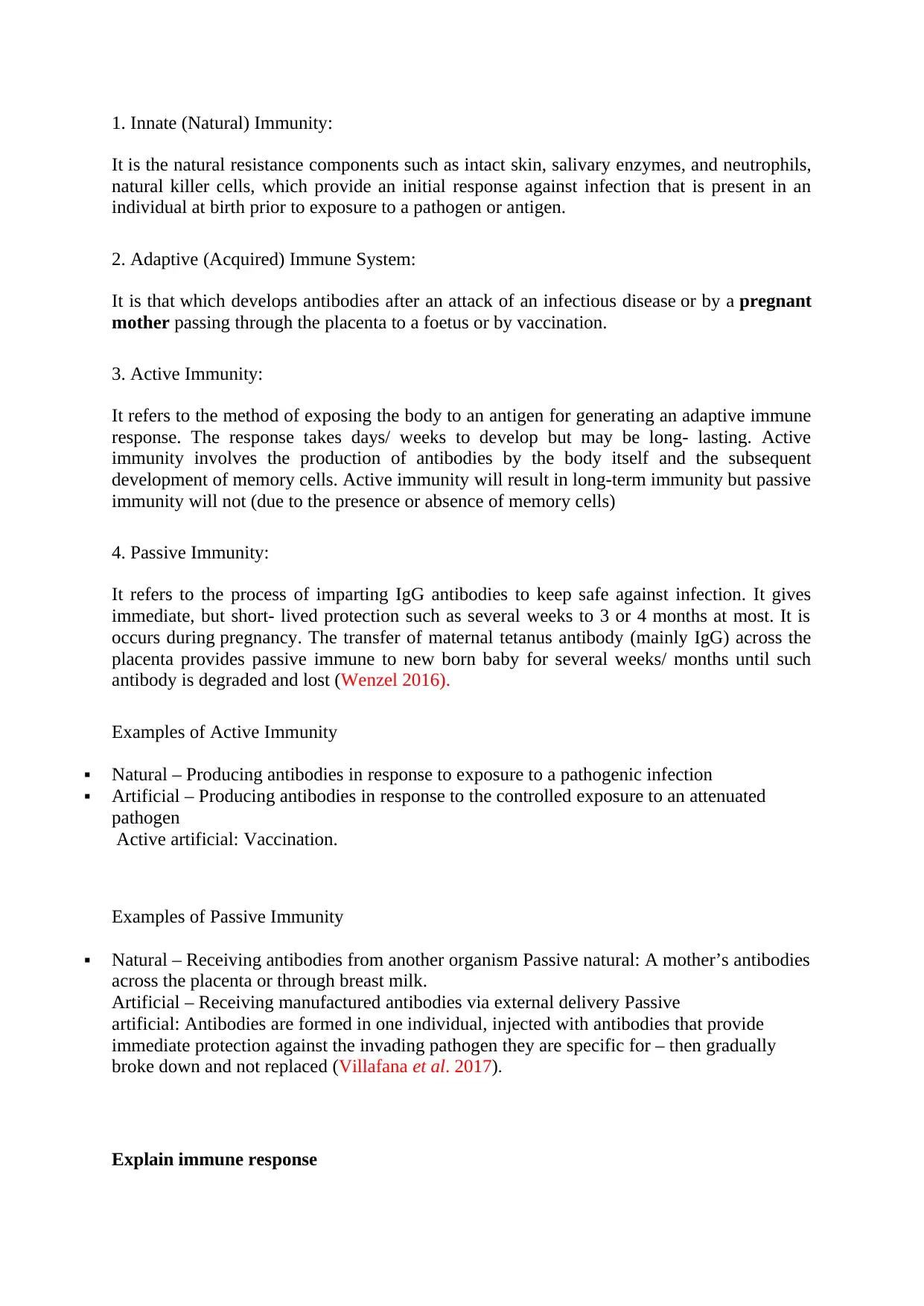
1. Innate (Natural) Immunity:
It is the natural resistance components such as intact skin, salivary enzymes, and neutrophils,
natural killer cells, which provide an initial response against infection that is present in an
individual at birth prior to exposure to a pathogen or antigen.
2. Adaptive (Acquired) Immune System:
It is that which develops antibodies after an attack of an infectious disease or by a pregnant
mother passing through the placenta to a foetus or by vaccination.
3. Active Immunity:
It refers to the method of exposing the body to an antigen for generating an adaptive immune
response. The response takes days/ weeks to develop but may be long- lasting. Active
immunity involves the production of antibodies by the body itself and the subsequent
development of memory cells. Active immunity will result in long-term immunity but passive
immunity will not (due to the presence or absence of memory cells)
4. Passive Immunity:
It refers to the process of imparting IgG antibodies to keep safe against infection. It gives
immediate, but short- lived protection such as several weeks to 3 or 4 months at most. It is
occurs during pregnancy. The transfer of maternal tetanus antibody (mainly IgG) across the
placenta provides passive immune to new born baby for several weeks/ months until such
antibody is degraded and lost (Wenzel 2016).
Examples of Active Immunity
Natural – Producing antibodies in response to exposure to a pathogenic infection
Artificial – Producing antibodies in response to the controlled exposure to an attenuated
pathogen
Active artificial: Vaccination.
Examples of Passive Immunity
Natural – Receiving antibodies from another organism Passive natural: A mother’s antibodies
across the placenta or through breast milk.
Artificial – Receiving manufactured antibodies via external delivery Passive
artificial: Antibodies are formed in one individual, injected with antibodies that provide
immediate protection against the invading pathogen they are specific for – then gradually
broke down and not replaced (Villafana et al. 2017).
Explain immune response
It is the natural resistance components such as intact skin, salivary enzymes, and neutrophils,
natural killer cells, which provide an initial response against infection that is present in an
individual at birth prior to exposure to a pathogen or antigen.
2. Adaptive (Acquired) Immune System:
It is that which develops antibodies after an attack of an infectious disease or by a pregnant
mother passing through the placenta to a foetus or by vaccination.
3. Active Immunity:
It refers to the method of exposing the body to an antigen for generating an adaptive immune
response. The response takes days/ weeks to develop but may be long- lasting. Active
immunity involves the production of antibodies by the body itself and the subsequent
development of memory cells. Active immunity will result in long-term immunity but passive
immunity will not (due to the presence or absence of memory cells)
4. Passive Immunity:
It refers to the process of imparting IgG antibodies to keep safe against infection. It gives
immediate, but short- lived protection such as several weeks to 3 or 4 months at most. It is
occurs during pregnancy. The transfer of maternal tetanus antibody (mainly IgG) across the
placenta provides passive immune to new born baby for several weeks/ months until such
antibody is degraded and lost (Wenzel 2016).
Examples of Active Immunity
Natural – Producing antibodies in response to exposure to a pathogenic infection
Artificial – Producing antibodies in response to the controlled exposure to an attenuated
pathogen
Active artificial: Vaccination.
Examples of Passive Immunity
Natural – Receiving antibodies from another organism Passive natural: A mother’s antibodies
across the placenta or through breast milk.
Artificial – Receiving manufactured antibodies via external delivery Passive
artificial: Antibodies are formed in one individual, injected with antibodies that provide
immediate protection against the invading pathogen they are specific for – then gradually
broke down and not replaced (Villafana et al. 2017).
Explain immune response
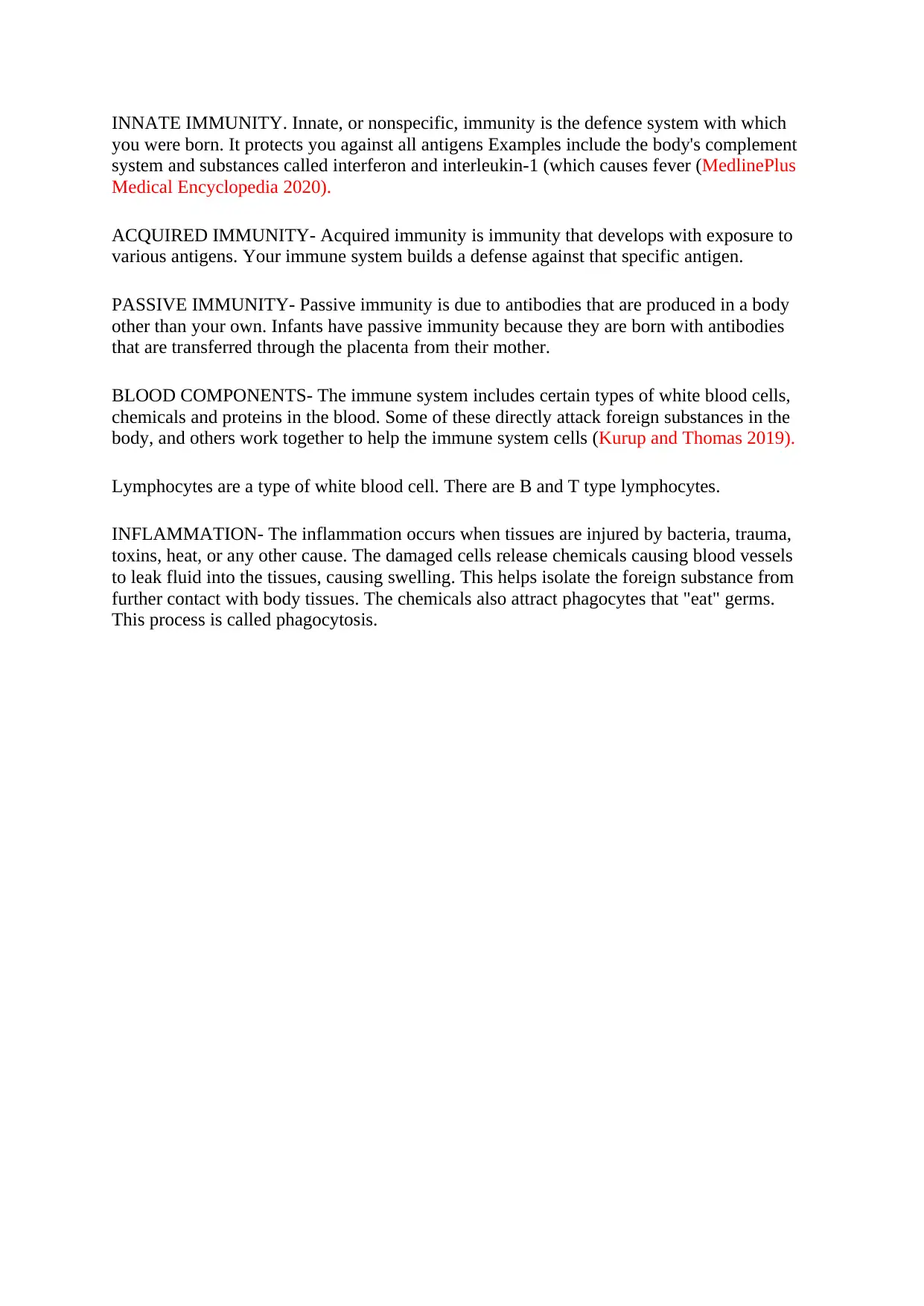
INNATE IMMUNITY. Innate, or nonspecific, immunity is the defence system with which
you were born. It protects you against all antigens Examples include the body's complement
system and substances called interferon and interleukin-1 (which causes fever (MedlinePlus
Medical Encyclopedia 2020).
ACQUIRED IMMUNITY- Acquired immunity is immunity that develops with exposure to
various antigens. Your immune system builds a defense against that specific antigen.
PASSIVE IMMUNITY- Passive immunity is due to antibodies that are produced in a body
other than your own. Infants have passive immunity because they are born with antibodies
that are transferred through the placenta from their mother.
BLOOD COMPONENTS- The immune system includes certain types of white blood cells,
chemicals and proteins in the blood. Some of these directly attack foreign substances in the
body, and others work together to help the immune system cells (Kurup and Thomas 2019).
Lymphocytes are a type of white blood cell. There are B and T type lymphocytes.
INFLAMMATION- The inflammation occurs when tissues are injured by bacteria, trauma,
toxins, heat, or any other cause. The damaged cells release chemicals causing blood vessels
to leak fluid into the tissues, causing swelling. This helps isolate the foreign substance from
further contact with body tissues. The chemicals also attract phagocytes that "eat" germs.
This process is called phagocytosis.
you were born. It protects you against all antigens Examples include the body's complement
system and substances called interferon and interleukin-1 (which causes fever (MedlinePlus
Medical Encyclopedia 2020).
ACQUIRED IMMUNITY- Acquired immunity is immunity that develops with exposure to
various antigens. Your immune system builds a defense against that specific antigen.
PASSIVE IMMUNITY- Passive immunity is due to antibodies that are produced in a body
other than your own. Infants have passive immunity because they are born with antibodies
that are transferred through the placenta from their mother.
BLOOD COMPONENTS- The immune system includes certain types of white blood cells,
chemicals and proteins in the blood. Some of these directly attack foreign substances in the
body, and others work together to help the immune system cells (Kurup and Thomas 2019).
Lymphocytes are a type of white blood cell. There are B and T type lymphocytes.
INFLAMMATION- The inflammation occurs when tissues are injured by bacteria, trauma,
toxins, heat, or any other cause. The damaged cells release chemicals causing blood vessels
to leak fluid into the tissues, causing swelling. This helps isolate the foreign substance from
further contact with body tissues. The chemicals also attract phagocytes that "eat" germs.
This process is called phagocytosis.
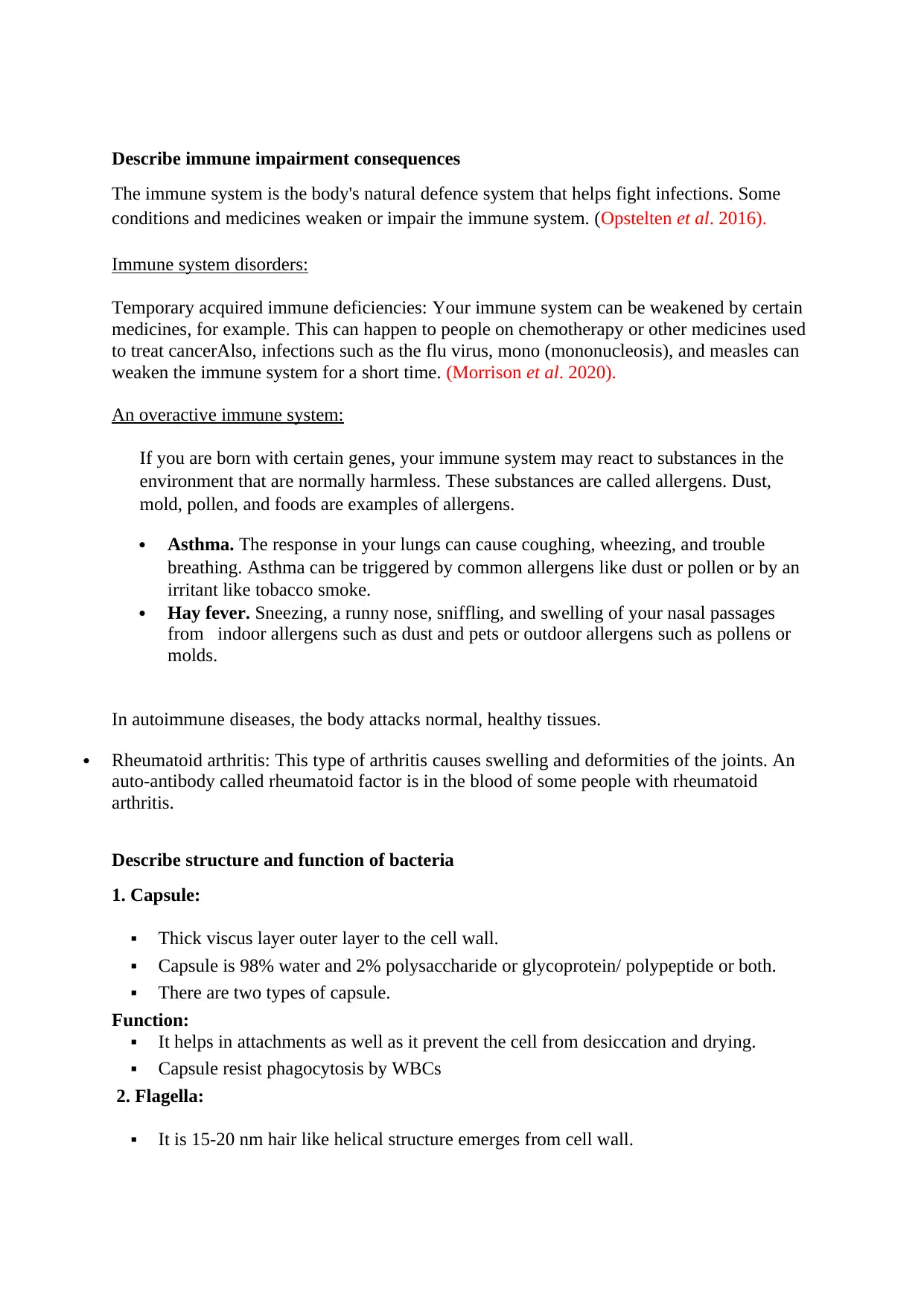
Describe immune impairment consequences
The immune system is the body's natural defence system that helps fight infections. Some
conditions and medicines weaken or impair the immune system. (Opstelten et al. 2016).
Immune system disorders:
Temporary acquired immune deficiencies: Your immune system can be weakened by certain
medicines, for example. This can happen to people on chemotherapy or other medicines used
to treat cancerAlso, infections such as the flu virus, mono (mononucleosis), and measles can
weaken the immune system for a short time. (Morrison et al. 2020).
An overactive immune system:
If you are born with certain genes, your immune system may react to substances in the
environment that are normally harmless. These substances are called allergens. Dust,
mold, pollen, and foods are examples of allergens.
Asthma. The response in your lungs can cause coughing, wheezing, and trouble
breathing. Asthma can be triggered by common allergens like dust or pollen or by an
irritant like tobacco smoke.
Hay fever. Sneezing, a runny nose, sniffling, and swelling of your nasal passages
from indoor allergens such as dust and pets or outdoor allergens such as pollens or
molds.
In autoimmune diseases, the body attacks normal, healthy tissues.
Rheumatoid arthritis: This type of arthritis causes swelling and deformities of the joints. An
auto-antibody called rheumatoid factor is in the blood of some people with rheumatoid
arthritis.
Describe structure and function of bacteria
1. Capsule:
Thick viscus layer outer layer to the cell wall.
Capsule is 98% water and 2% polysaccharide or glycoprotein/ polypeptide or both.
There are two types of capsule.
Function:
It helps in attachments as well as it prevent the cell from desiccation and drying.
Capsule resist phagocytosis by WBCs
2. Flagella:
It is 15-20 nm hair like helical structure emerges from cell wall.
The immune system is the body's natural defence system that helps fight infections. Some
conditions and medicines weaken or impair the immune system. (Opstelten et al. 2016).
Immune system disorders:
Temporary acquired immune deficiencies: Your immune system can be weakened by certain
medicines, for example. This can happen to people on chemotherapy or other medicines used
to treat cancerAlso, infections such as the flu virus, mono (mononucleosis), and measles can
weaken the immune system for a short time. (Morrison et al. 2020).
An overactive immune system:
If you are born with certain genes, your immune system may react to substances in the
environment that are normally harmless. These substances are called allergens. Dust,
mold, pollen, and foods are examples of allergens.
Asthma. The response in your lungs can cause coughing, wheezing, and trouble
breathing. Asthma can be triggered by common allergens like dust or pollen or by an
irritant like tobacco smoke.
Hay fever. Sneezing, a runny nose, sniffling, and swelling of your nasal passages
from indoor allergens such as dust and pets or outdoor allergens such as pollens or
molds.
In autoimmune diseases, the body attacks normal, healthy tissues.
Rheumatoid arthritis: This type of arthritis causes swelling and deformities of the joints. An
auto-antibody called rheumatoid factor is in the blood of some people with rheumatoid
arthritis.
Describe structure and function of bacteria
1. Capsule:
Thick viscus layer outer layer to the cell wall.
Capsule is 98% water and 2% polysaccharide or glycoprotein/ polypeptide or both.
There are two types of capsule.
Function:
It helps in attachments as well as it prevent the cell from desiccation and drying.
Capsule resist phagocytosis by WBCs
2. Flagella:
It is 15-20 nm hair like helical structure emerges from cell wall.
Paraphrase This Document
Need a fresh take? Get an instant paraphrase of this document with our AI Paraphraser
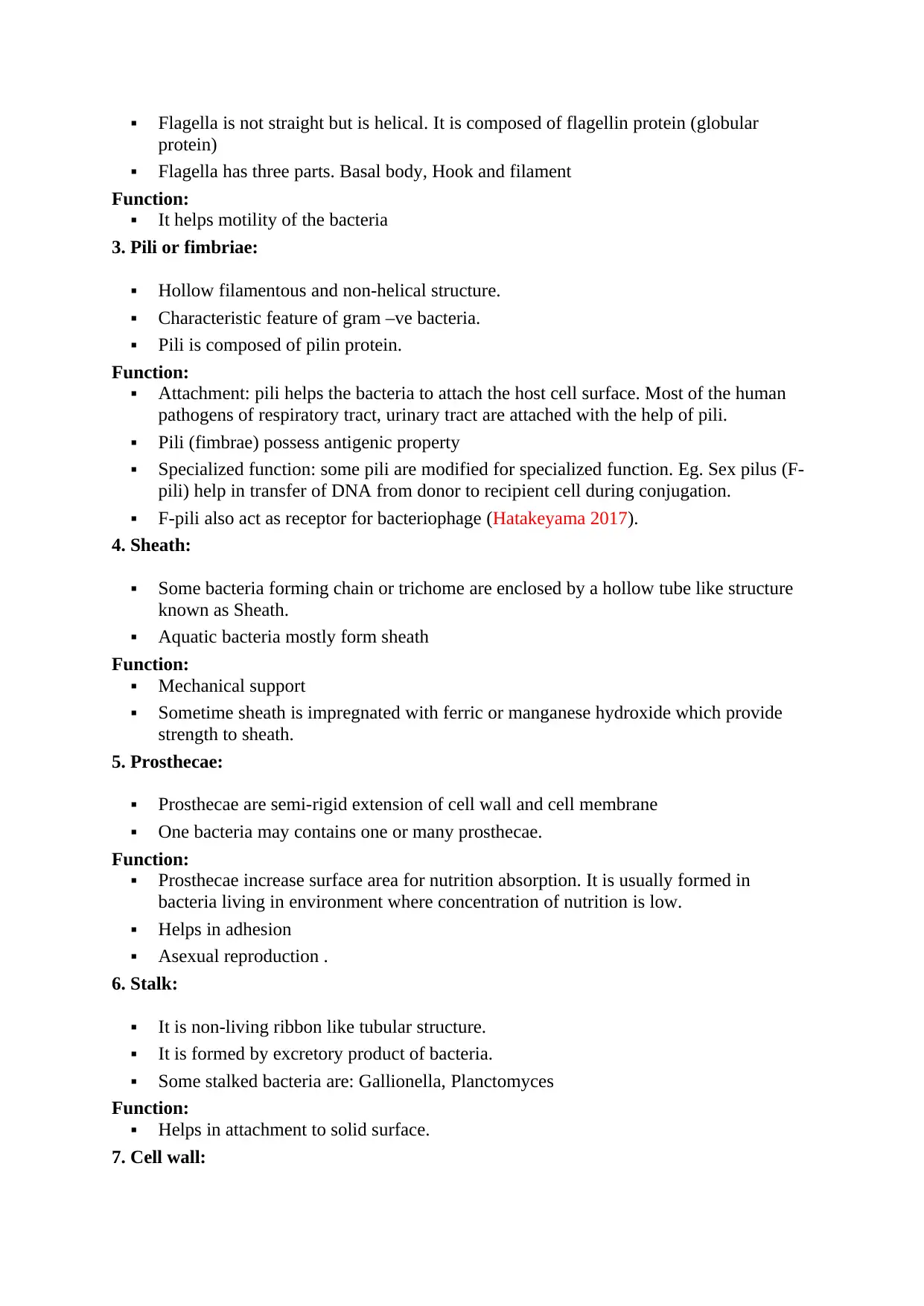
Flagella is not straight but is helical. It is composed of flagellin protein (globular
protein)
Flagella has three parts. Basal body, Hook and filament
Function:
It helps motility of the bacteria
3. Pili or fimbriae:
Hollow filamentous and non-helical structure.
Characteristic feature of gram –ve bacteria.
Pili is composed of pilin protein.
Function:
Attachment: pili helps the bacteria to attach the host cell surface. Most of the human
pathogens of respiratory tract, urinary tract are attached with the help of pili.
Pili (fimbrae) possess antigenic property
Specialized function: some pili are modified for specialized function. Eg. Sex pilus (F-
pili) help in transfer of DNA from donor to recipient cell during conjugation.
F-pili also act as receptor for bacteriophage (Hatakeyama 2017).
4. Sheath:
Some bacteria forming chain or trichome are enclosed by a hollow tube like structure
known as Sheath.
Aquatic bacteria mostly form sheath
Function:
Mechanical support
Sometime sheath is impregnated with ferric or manganese hydroxide which provide
strength to sheath.
5. Prosthecae:
Prosthecae are semi-rigid extension of cell wall and cell membrane
One bacteria may contains one or many prosthecae.
Function:
Prosthecae increase surface area for nutrition absorption. It is usually formed in
bacteria living in environment where concentration of nutrition is low.
Helps in adhesion
Asexual reproduction .
6. Stalk:
It is non-living ribbon like tubular structure.
It is formed by excretory product of bacteria.
Some stalked bacteria are: Gallionella, Planctomyces
Function:
Helps in attachment to solid surface.
7. Cell wall:
protein)
Flagella has three parts. Basal body, Hook and filament
Function:
It helps motility of the bacteria
3. Pili or fimbriae:
Hollow filamentous and non-helical structure.
Characteristic feature of gram –ve bacteria.
Pili is composed of pilin protein.
Function:
Attachment: pili helps the bacteria to attach the host cell surface. Most of the human
pathogens of respiratory tract, urinary tract are attached with the help of pili.
Pili (fimbrae) possess antigenic property
Specialized function: some pili are modified for specialized function. Eg. Sex pilus (F-
pili) help in transfer of DNA from donor to recipient cell during conjugation.
F-pili also act as receptor for bacteriophage (Hatakeyama 2017).
4. Sheath:
Some bacteria forming chain or trichome are enclosed by a hollow tube like structure
known as Sheath.
Aquatic bacteria mostly form sheath
Function:
Mechanical support
Sometime sheath is impregnated with ferric or manganese hydroxide which provide
strength to sheath.
5. Prosthecae:
Prosthecae are semi-rigid extension of cell wall and cell membrane
One bacteria may contains one or many prosthecae.
Function:
Prosthecae increase surface area for nutrition absorption. It is usually formed in
bacteria living in environment where concentration of nutrition is low.
Helps in adhesion
Asexual reproduction .
6. Stalk:
It is non-living ribbon like tubular structure.
It is formed by excretory product of bacteria.
Some stalked bacteria are: Gallionella, Planctomyces
Function:
Helps in attachment to solid surface.
7. Cell wall:
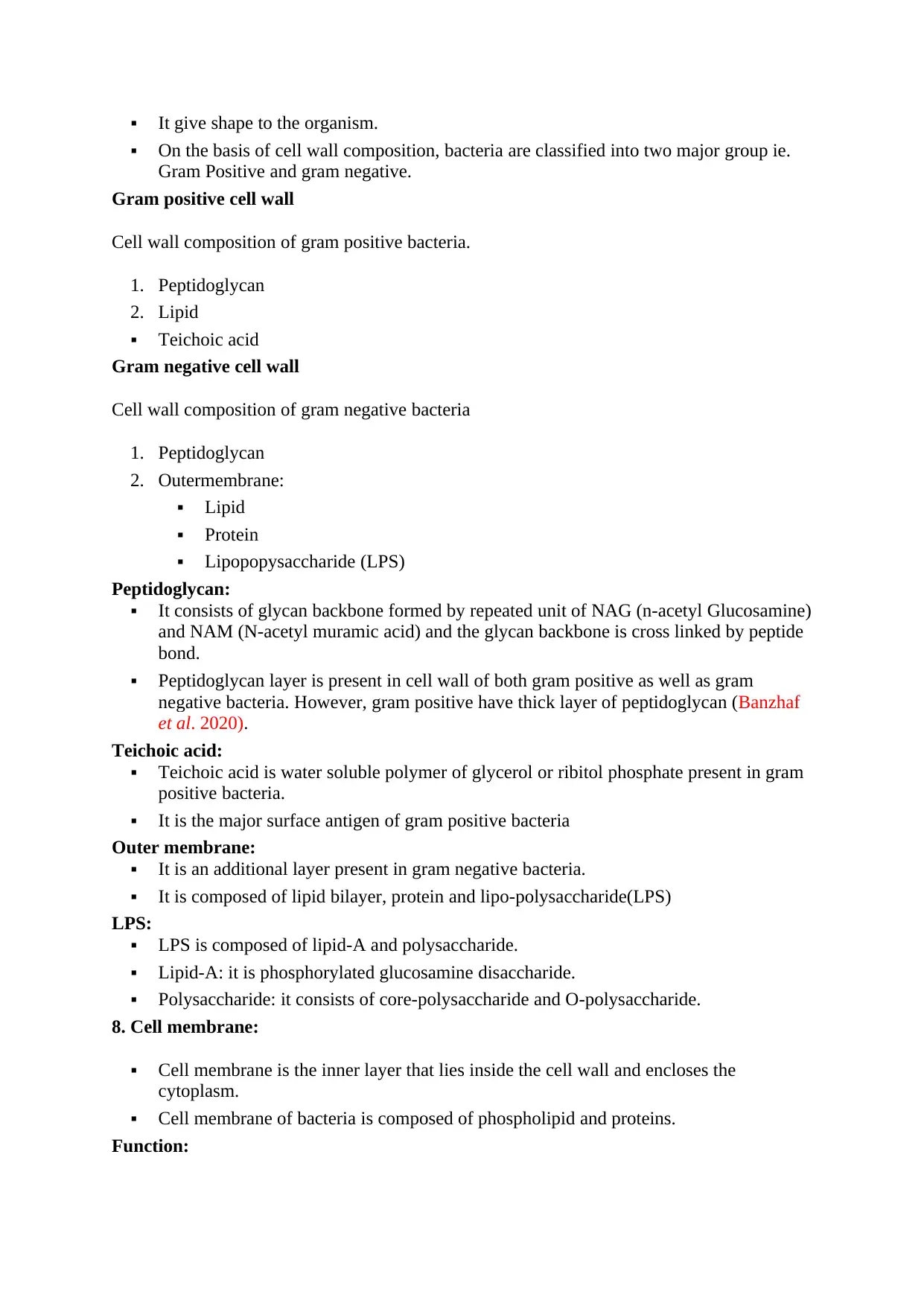
It give shape to the organism.
On the basis of cell wall composition, bacteria are classified into two major group ie.
Gram Positive and gram negative.
Gram positive cell wall
Cell wall composition of gram positive bacteria.
1. Peptidoglycan
2. Lipid
Teichoic acid
Gram negative cell wall
Cell wall composition of gram negative bacteria
1. Peptidoglycan
2. Outermembrane:
Lipid
Protein
Lipopopysaccharide (LPS)
Peptidoglycan:
It consists of glycan backbone formed by repeated unit of NAG (n-acetyl Glucosamine)
and NAM (N-acetyl muramic acid) and the glycan backbone is cross linked by peptide
bond.
Peptidoglycan layer is present in cell wall of both gram positive as well as gram
negative bacteria. However, gram positive have thick layer of peptidoglycan (Banzhaf
et al. 2020).
Teichoic acid:
Teichoic acid is water soluble polymer of glycerol or ribitol phosphate present in gram
positive bacteria.
It is the major surface antigen of gram positive bacteria
Outer membrane:
It is an additional layer present in gram negative bacteria.
It is composed of lipid bilayer, protein and lipo-polysaccharide(LPS)
LPS:
LPS is composed of lipid-A and polysaccharide.
Lipid-A: it is phosphorylated glucosamine disaccharide.
Polysaccharide: it consists of core-polysaccharide and O-polysaccharide.
8. Cell membrane:
Cell membrane is the inner layer that lies inside the cell wall and encloses the
cytoplasm.
Cell membrane of bacteria is composed of phospholipid and proteins.
Function:
On the basis of cell wall composition, bacteria are classified into two major group ie.
Gram Positive and gram negative.
Gram positive cell wall
Cell wall composition of gram positive bacteria.
1. Peptidoglycan
2. Lipid
Teichoic acid
Gram negative cell wall
Cell wall composition of gram negative bacteria
1. Peptidoglycan
2. Outermembrane:
Lipid
Protein
Lipopopysaccharide (LPS)
Peptidoglycan:
It consists of glycan backbone formed by repeated unit of NAG (n-acetyl Glucosamine)
and NAM (N-acetyl muramic acid) and the glycan backbone is cross linked by peptide
bond.
Peptidoglycan layer is present in cell wall of both gram positive as well as gram
negative bacteria. However, gram positive have thick layer of peptidoglycan (Banzhaf
et al. 2020).
Teichoic acid:
Teichoic acid is water soluble polymer of glycerol or ribitol phosphate present in gram
positive bacteria.
It is the major surface antigen of gram positive bacteria
Outer membrane:
It is an additional layer present in gram negative bacteria.
It is composed of lipid bilayer, protein and lipo-polysaccharide(LPS)
LPS:
LPS is composed of lipid-A and polysaccharide.
Lipid-A: it is phosphorylated glucosamine disaccharide.
Polysaccharide: it consists of core-polysaccharide and O-polysaccharide.
8. Cell membrane:
Cell membrane is the inner layer that lies inside the cell wall and encloses the
cytoplasm.
Cell membrane of bacteria is composed of phospholipid and proteins.
Function:
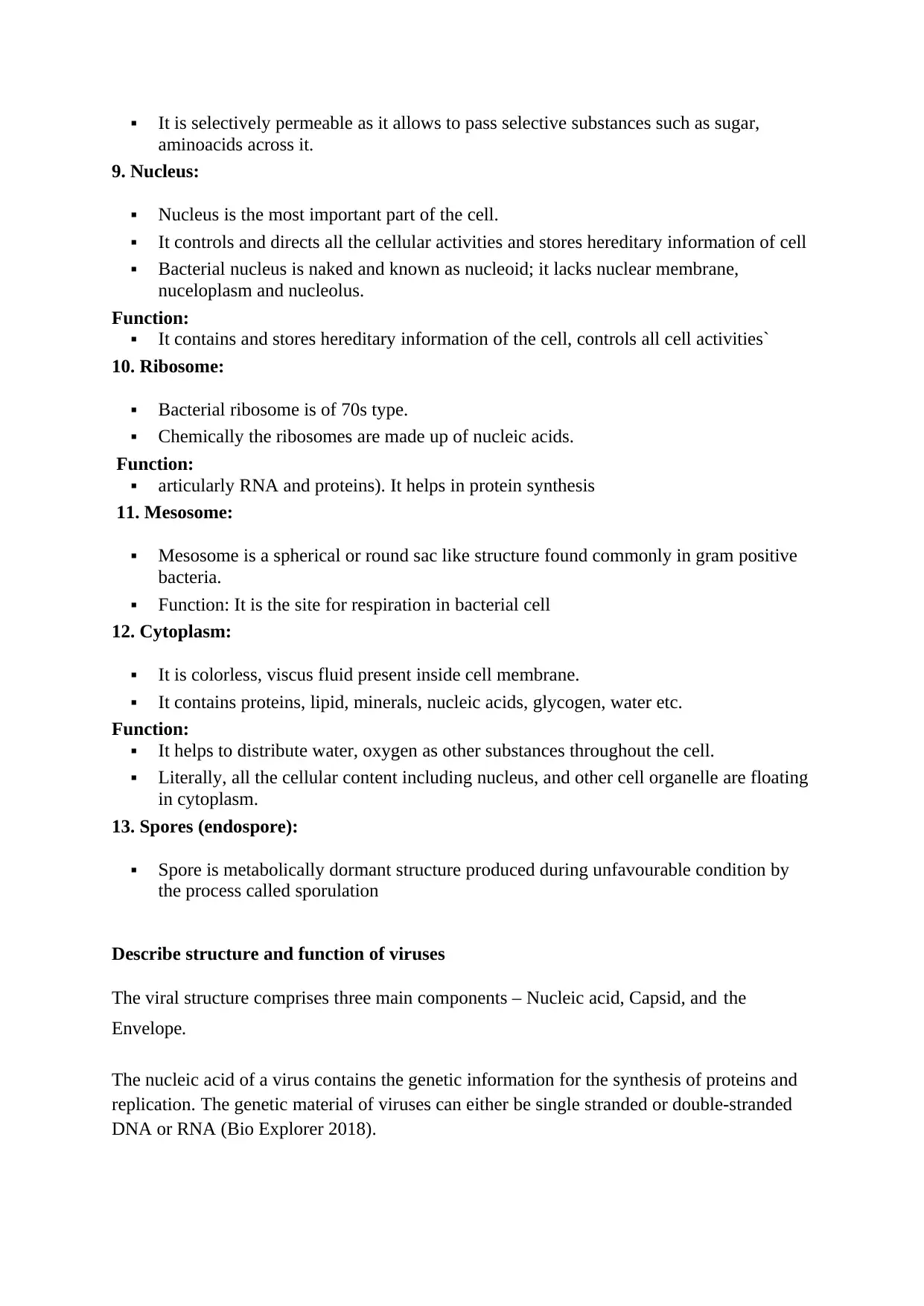
It is selectively permeable as it allows to pass selective substances such as sugar,
aminoacids across it.
9. Nucleus:
Nucleus is the most important part of the cell.
It controls and directs all the cellular activities and stores hereditary information of cell
Bacterial nucleus is naked and known as nucleoid; it lacks nuclear membrane,
nuceloplasm and nucleolus.
Function:
It contains and stores hereditary information of the cell, controls all cell activities`
10. Ribosome:
Bacterial ribosome is of 70s type.
Chemically the ribosomes are made up of nucleic acids.
Function:
articularly RNA and proteins). It helps in protein synthesis
11. Mesosome:
Mesosome is a spherical or round sac like structure found commonly in gram positive
bacteria.
Function: It is the site for respiration in bacterial cell
12. Cytoplasm:
It is colorless, viscus fluid present inside cell membrane.
It contains proteins, lipid, minerals, nucleic acids, glycogen, water etc.
Function:
It helps to distribute water, oxygen as other substances throughout the cell.
Literally, all the cellular content including nucleus, and other cell organelle are floating
in cytoplasm.
13. Spores (endospore):
Spore is metabolically dormant structure produced during unfavourable condition by
the process called sporulation
Describe structure and function of viruses
The viral structure comprises three main components – Nucleic acid, Capsid, and the
Envelope.
The nucleic acid of a virus contains the genetic information for the synthesis of proteins and
replication. The genetic material of viruses can either be single stranded or double-stranded
DNA or RNA (Bio Explorer 2018).
aminoacids across it.
9. Nucleus:
Nucleus is the most important part of the cell.
It controls and directs all the cellular activities and stores hereditary information of cell
Bacterial nucleus is naked and known as nucleoid; it lacks nuclear membrane,
nuceloplasm and nucleolus.
Function:
It contains and stores hereditary information of the cell, controls all cell activities`
10. Ribosome:
Bacterial ribosome is of 70s type.
Chemically the ribosomes are made up of nucleic acids.
Function:
articularly RNA and proteins). It helps in protein synthesis
11. Mesosome:
Mesosome is a spherical or round sac like structure found commonly in gram positive
bacteria.
Function: It is the site for respiration in bacterial cell
12. Cytoplasm:
It is colorless, viscus fluid present inside cell membrane.
It contains proteins, lipid, minerals, nucleic acids, glycogen, water etc.
Function:
It helps to distribute water, oxygen as other substances throughout the cell.
Literally, all the cellular content including nucleus, and other cell organelle are floating
in cytoplasm.
13. Spores (endospore):
Spore is metabolically dormant structure produced during unfavourable condition by
the process called sporulation
Describe structure and function of viruses
The viral structure comprises three main components – Nucleic acid, Capsid, and the
Envelope.
The nucleic acid of a virus contains the genetic information for the synthesis of proteins and
replication. The genetic material of viruses can either be single stranded or double-stranded
DNA or RNA (Bio Explorer 2018).
Secure Best Marks with AI Grader
Need help grading? Try our AI Grader for instant feedback on your assignments.
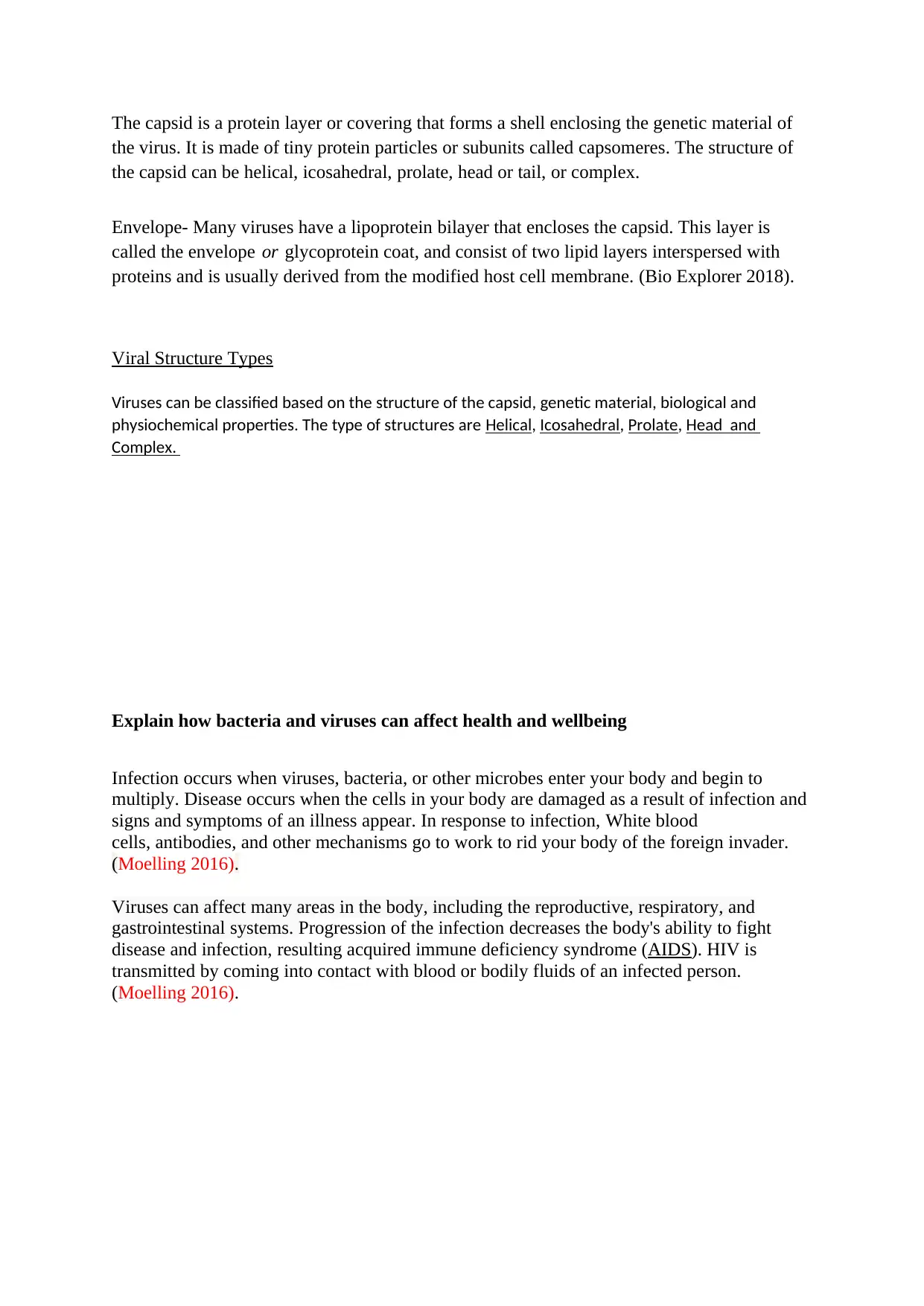
The capsid is a protein layer or covering that forms a shell enclosing the genetic material of
the virus. It is made of tiny protein particles or subunits called capsomeres. The structure of
the capsid can be helical, icosahedral, prolate, head or tail, or complex.
Envelope- Many viruses have a lipoprotein bilayer that encloses the capsid. This layer is
called the envelope or glycoprotein coat, and consist of two lipid layers interspersed with
proteins and is usually derived from the modified host cell membrane. (Bio Explorer 2018).
Viral Structure Types
Viruses can be classified based on the structure of the capsid, genetic material, biological and
physiochemical properties. The type of structures are Helical, Icosahedral, Prolate, Head and
Complex.
Explain how bacteria and viruses can affect health and wellbeing
Infection occurs when viruses, bacteria, or other microbes enter your body and begin to
multiply. Disease occurs when the cells in your body are damaged as a result of infection and
signs and symptoms of an illness appear. In response to infection, White blood
cells, antibodies, and other mechanisms go to work to rid your body of the foreign invader.
(Moelling 2016).
Viruses can affect many areas in the body, including the reproductive, respiratory, and
gastrointestinal systems. Progression of the infection decreases the body's ability to fight
disease and infection, resulting acquired immune deficiency syndrome (AIDS). HIV is
transmitted by coming into contact with blood or bodily fluids of an infected person.
(Moelling 2016).
the virus. It is made of tiny protein particles or subunits called capsomeres. The structure of
the capsid can be helical, icosahedral, prolate, head or tail, or complex.
Envelope- Many viruses have a lipoprotein bilayer that encloses the capsid. This layer is
called the envelope or glycoprotein coat, and consist of two lipid layers interspersed with
proteins and is usually derived from the modified host cell membrane. (Bio Explorer 2018).
Viral Structure Types
Viruses can be classified based on the structure of the capsid, genetic material, biological and
physiochemical properties. The type of structures are Helical, Icosahedral, Prolate, Head and
Complex.
Explain how bacteria and viruses can affect health and wellbeing
Infection occurs when viruses, bacteria, or other microbes enter your body and begin to
multiply. Disease occurs when the cells in your body are damaged as a result of infection and
signs and symptoms of an illness appear. In response to infection, White blood
cells, antibodies, and other mechanisms go to work to rid your body of the foreign invader.
(Moelling 2016).
Viruses can affect many areas in the body, including the reproductive, respiratory, and
gastrointestinal systems. Progression of the infection decreases the body's ability to fight
disease and infection, resulting acquired immune deficiency syndrome (AIDS). HIV is
transmitted by coming into contact with blood or bodily fluids of an infected person.
(Moelling 2016).
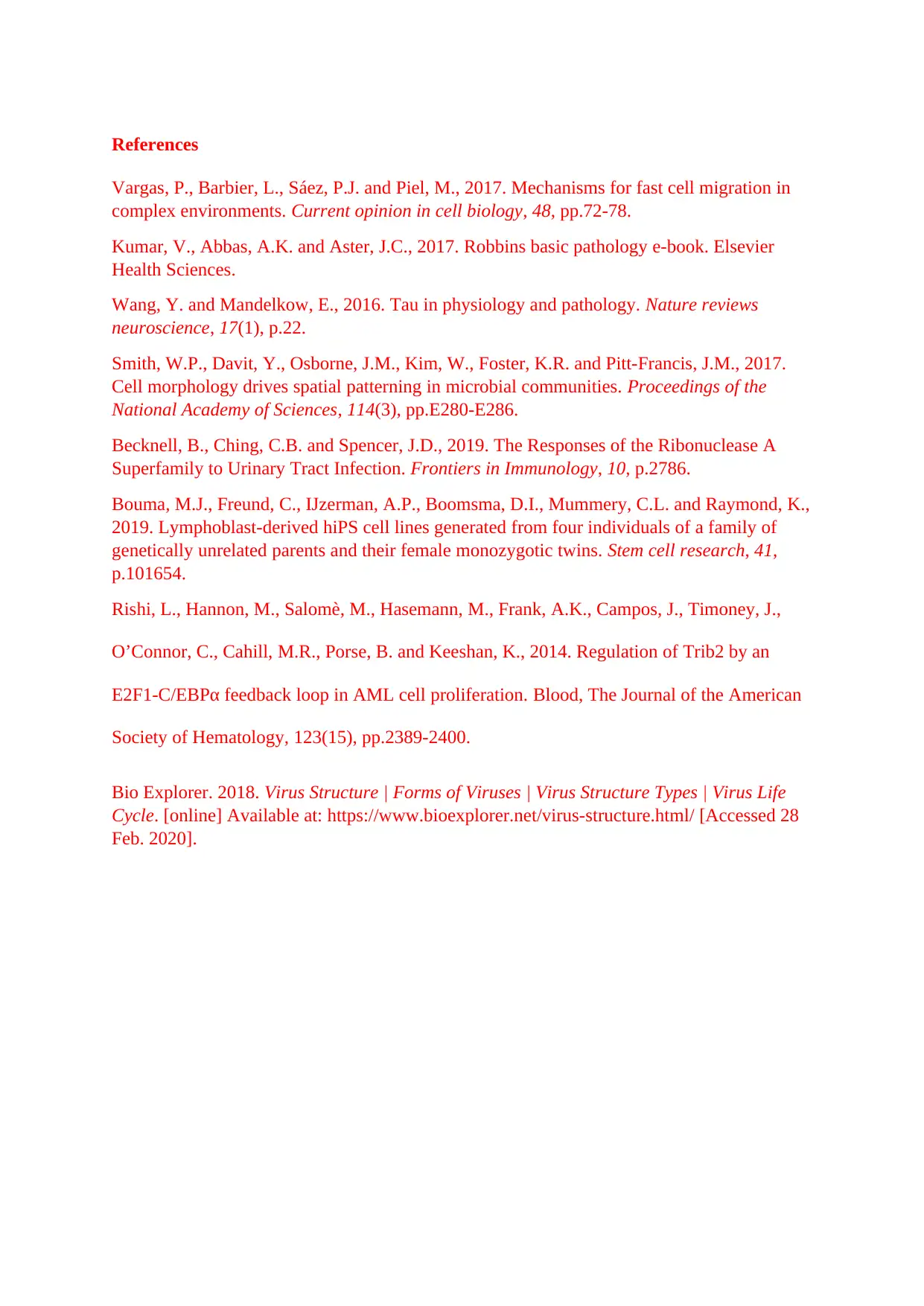
References
Vargas, P., Barbier, L., Sáez, P.J. and Piel, M., 2017. Mechanisms for fast cell migration in
complex environments. Current opinion in cell biology, 48, pp.72-78.
Kumar, V., Abbas, A.K. and Aster, J.C., 2017. Robbins basic pathology e-book. Elsevier
Health Sciences.
Wang, Y. and Mandelkow, E., 2016. Tau in physiology and pathology. Nature reviews
neuroscience, 17(1), p.22.
Smith, W.P., Davit, Y., Osborne, J.M., Kim, W., Foster, K.R. and Pitt-Francis, J.M., 2017.
Cell morphology drives spatial patterning in microbial communities. Proceedings of the
National Academy of Sciences, 114(3), pp.E280-E286.
Becknell, B., Ching, C.B. and Spencer, J.D., 2019. The Responses of the Ribonuclease A
Superfamily to Urinary Tract Infection. Frontiers in Immunology, 10, p.2786.
Bouma, M.J., Freund, C., IJzerman, A.P., Boomsma, D.I., Mummery, C.L. and Raymond, K.,
2019. Lymphoblast-derived hiPS cell lines generated from four individuals of a family of
genetically unrelated parents and their female monozygotic twins. Stem cell research, 41,
p.101654.
Rishi, L., Hannon, M., Salomè, M., Hasemann, M., Frank, A.K., Campos, J., Timoney, J.,
O’Connor, C., Cahill, M.R., Porse, B. and Keeshan, K., 2014. Regulation of Trib2 by an
E2F1-C/EBPα feedback loop in AML cell proliferation. Blood, The Journal of the American
Society of Hematology, 123(15), pp.2389-2400.
Bio Explorer. 2018. Virus Structure | Forms of Viruses | Virus Structure Types | Virus Life
Cycle. [online] Available at: https://www.bioexplorer.net/virus-structure.html/ [Accessed 28
Feb. 2020].
Vargas, P., Barbier, L., Sáez, P.J. and Piel, M., 2017. Mechanisms for fast cell migration in
complex environments. Current opinion in cell biology, 48, pp.72-78.
Kumar, V., Abbas, A.K. and Aster, J.C., 2017. Robbins basic pathology e-book. Elsevier
Health Sciences.
Wang, Y. and Mandelkow, E., 2016. Tau in physiology and pathology. Nature reviews
neuroscience, 17(1), p.22.
Smith, W.P., Davit, Y., Osborne, J.M., Kim, W., Foster, K.R. and Pitt-Francis, J.M., 2017.
Cell morphology drives spatial patterning in microbial communities. Proceedings of the
National Academy of Sciences, 114(3), pp.E280-E286.
Becknell, B., Ching, C.B. and Spencer, J.D., 2019. The Responses of the Ribonuclease A
Superfamily to Urinary Tract Infection. Frontiers in Immunology, 10, p.2786.
Bouma, M.J., Freund, C., IJzerman, A.P., Boomsma, D.I., Mummery, C.L. and Raymond, K.,
2019. Lymphoblast-derived hiPS cell lines generated from four individuals of a family of
genetically unrelated parents and their female monozygotic twins. Stem cell research, 41,
p.101654.
Rishi, L., Hannon, M., Salomè, M., Hasemann, M., Frank, A.K., Campos, J., Timoney, J.,
O’Connor, C., Cahill, M.R., Porse, B. and Keeshan, K., 2014. Regulation of Trib2 by an
E2F1-C/EBPα feedback loop in AML cell proliferation. Blood, The Journal of the American
Society of Hematology, 123(15), pp.2389-2400.
Bio Explorer. 2018. Virus Structure | Forms of Viruses | Virus Structure Types | Virus Life
Cycle. [online] Available at: https://www.bioexplorer.net/virus-structure.html/ [Accessed 28
Feb. 2020].
1 out of 12
Your All-in-One AI-Powered Toolkit for Academic Success.
+13062052269
info@desklib.com
Available 24*7 on WhatsApp / Email
![[object Object]](/_next/static/media/star-bottom.7253800d.svg)
Unlock your academic potential
© 2024 | Zucol Services PVT LTD | All rights reserved.
